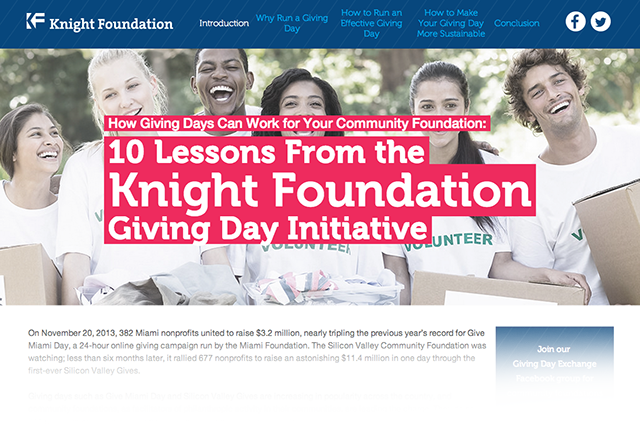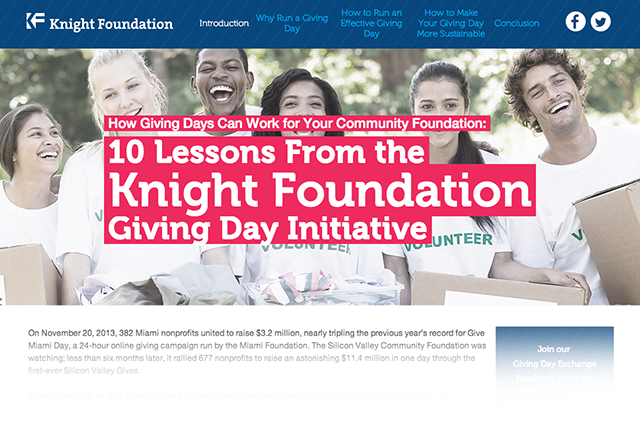
Motivating donors: Which prizes work best for Giving Days
Anyone who has hosted an online giving campaign can relate to the exhilaration that comes when the total-amount-raised tracker goes up and up and up. Prizes offered throughout Giving Days, or online fundraising sprints, are a big part of generating that excitement and keeping donors and nonprofits engaged.
Related Link
“Giving Day Peer Learning group” on Facebook
“10 lessons for Giving Days, and one question: How can we make them more sustainable?” by Bahia Ramos on Knight Blog
“New Report Provides 10 Lessons for Foundations Planning Giving Days” – Press release
But what prizes are most effective in motivating donors? How can matching funds be used to keep the momentum going during a 24-hour campaign? Below are some insights we’ve learned through an evaluation of the Giving Days run by community foundations that Knight Foundation supports. These insights build on Knight’s new report that contains 10 lessons for Giving Days.Prizes that work
Here are the types of prizes that will give you the most bang for your buck: Those for Highest Total Giving, Most Unique Donors and Most Unique Donations.
Almost all of the Knight-supported Giving Days used these prizes to incentivize donations. For these prizes to work, an online leaderboard with the frontrunners in these categories needs to be displayed on the Giving Day website. Since these prizes were offered the entire length of the Giving Day, it’s hard to quantify how effective they were without a comparison to times when these prizes weren’t offered. Nevertheless these prizes serve an important role as they encourage nonprofits to continue fundraising throughout the day.Post by PETS, Inc – The Carolinas Humane Society.
Social Media Incentives
Three community foundations in Knight’s Giving Day initiative used prizes to increase buzz on social media. Central Carolina’s Midland Gives, for example, awarded $1,000 to the organization that had the most tweets using the hashtag #midlandgives. Tying the prizes to specific nonprofit or donor behavior was effective as it increased the social media traffic at specific times during the Giving Day and boosted the organizing community foundation’s social media following in the long term as well.
Quick Start
A “quick start” prize incentivized donors to give during the first hour of a Giving Day and was used to garner early excitement. Giving Days that did offer this prize saw increased amounts of giving during the first hour when compared to the second hour in the Giving Day. The Miami Foundation for example offered a prize for the first gift made on a Giving Day and had 536 percent more donations in the first hour than in the second hour. Centre Community Foundation offered a prize for the first organization with 25 donations and had 1,115 percent more donations in its first hour than the second.
Power Hours
A “power hour” awards a prize to the nonprofit that receives the most money, unique donors or donations in a single hour during a Giving Day. The “power hours” were used to incentive increased giving or more unique donations during specific periods of time, such as an hour that might typically have less traffic. All Giving Days that offered this prize saw an increase in their desired behavior during the power hour. For example, GiveMN donors were 22 percent more generous during times that power hours were offered.
Matching Funds
Hours where donations were matched by the community foundation dollar for dollar (or in some cases two dollars to one dollar) until the match pool was exhausted saw much higher levels of donations but the funds quickly ran out. Silicon Valley Community Foundation used this strategy during its Giving Day. Hours where matches were offered raised 153 percent more dollars and had 67 percent more donations on average when compared with other hours. Interestingly, the difference in amount raised between the 2:1 and 1:1 matches offered by Silicon Valley was minimal, with the 1:1 matches only bringing in 4 percent less in total donations. The matching funds strategy has been effective in increasing donations but should be used with time constraints.Prizes that can fizzle
Here are prizes that were less effective at incentivizing donor behavior:
Golden Tickets
A golden ticket, or randomly drawn prize, was offered by many Giving Day organizations. These prizes were good in incentivizing more donations when they were offered. However, the donation amounts were smaller as donors were more likely to give multiple times in lesser amounts to increase the odds of winning the prize.
Milestone Prizes
These prizes were awarded to nonprofits for donations made at an exact time of day or for hitting a specific milestone, for example a prize for the 1,950th donation to commemorate the community foundation’s founding in 1950. These prizes were not successful in incentivizing donor behavior as they are hard to predict and winning is really based on luck of the draw. These types of prizes are generally meaningful for the community foundation, yet they appear to be unsuccessful at increasing donations or other donor behavior.
Big Finish
This prize is similar to the “quick start” prize but is used to incentivize donors during the last hour of the Giving Day. Community foundations that offered this prize saw fewer donations during that time period compared to other hours. It is likely that at the end of the Giving Day nonprofits and donors are fatigued, but it’s unclear from our data why this prize didn’t work.
The effectiveness of prizes and matching funds is just one of the lessons we’ve learned through a review of our Giving Day initiative. More examples and lessons from Giving Days can be found in the report “How Giving Days Can Work for Your Community Foundation: 10 Lessons From the Knight Foundation Giving Day Initiative.” We are continuing the conversation too on the Giving Day Exchange group on Facebook, where community foundation organizers can swap insights with others who are also in the trenches. We are also participating in a special deep dive session at the Council on Foundations’ fall conference in October. We hope to see you there.
Anna Dilernia is an assistant on the strategy and assessment team at Knight Foundation.
Recent Content
-
Artsarticle ·
-
Artsarticle ·
-
Artsarticle ·


